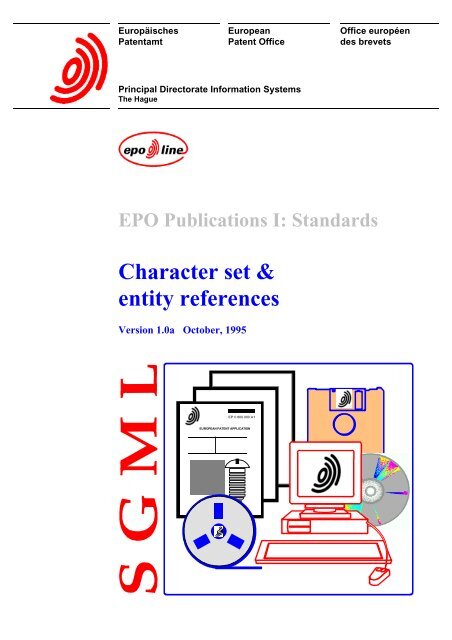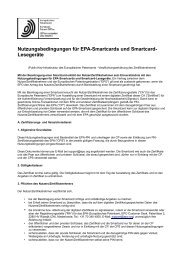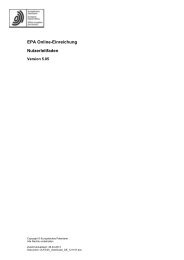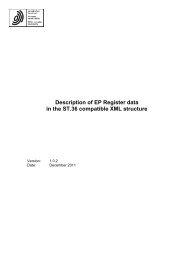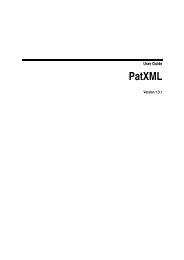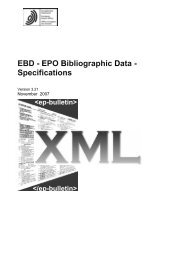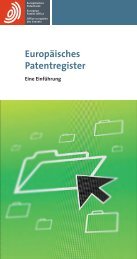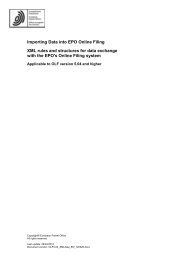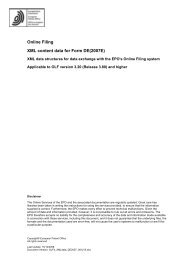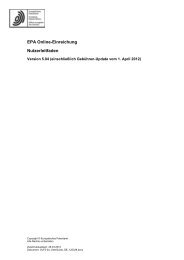Character set & entity references - EPO
Character set & entity references - EPO
Character set & entity references - EPO
Create successful ePaper yourself
Turn your PDF publications into a flip-book with our unique Google optimized e-Paper software.
<strong>EPO</strong> <strong>Character</strong> <strong>set</strong> and <strong>entity</strong> <strong>references</strong> Version 1.0a, October 1995<strong>EPO</strong> CHARACTER SET AND ENTITY REFERENCESIntroductionOne of the most common problems in data transfer between computer systems, which may be thesame or completely different systems, is whether or not they ‘speak the same language’ at the mostbasic level - the character <strong>set</strong> level used to encode data. A character <strong>set</strong> is:"a <strong>set</strong> of characters that is handled by a specific machine. The <strong>set</strong> usually includes theEnglish alphanumeric characters, special characters and operation characters, all of whichare graphics characters, and various control characters. Graphic characters thus denote aprinted mark or a space while control characters produce some particular effect."A character <strong>set</strong> is contained in a code page. The simplest code page, which is an internationalstandard, is ISO 646: 1983 IRV (International Reference Version). However, this character <strong>set</strong> is sobasic that to utilise it in an environment such as the <strong>EPO</strong> would mean the substitution of manycharacters, such as accented characters, with <strong>entity</strong> <strong>references</strong> (explained below).Probably the most common code page of characters used on computers is ASCII (American StandardCode for Information Interchange), which, in its 7-bit version (128 characters), is almost identicalwith ISO 646. However, when people talk about ASCII they almost always mean extended ASCII -an 8 bit character <strong>set</strong> of 256 characters. This character <strong>set</strong> is more useful, to the <strong>EPO</strong>, because itcontains, for example, accented characters. The picture is complicated further in that there aredifferent code pages for extended ASCII, especially on IBM compatible PCs. Here the most commonare known as code pages 437 and 850. Code page 850 is used in the <strong>EPO</strong> because it is multilingualand, therefore, has more accented characters for so-called Swiss-German keyboards; but thecommonest code page is probably IBM code page 437. In creating the character <strong>set</strong> used by the <strong>EPO</strong>we have taken this fact into account and ‘mapped’ our base code page to be compliant with ASCII437 and 850.Most <strong>EPO</strong> computer systems and projects process data on the <strong>EPO</strong>’s IBM 9000 series mainframe -one of the code pages on this system is IBM EBCDIC (Extended Binary Coded Decimal InterchangeCode) Code Page 500. This is an internationally recognised code page for EBCDIC. In re-designingthe <strong>EPO</strong> publication system we have decided to use this code page as it is the most convenient to usein the <strong>EPO</strong> environment (most, if not all, <strong>EPO</strong> workstations can display and print the characters inthis code page).However, not all the codes on code page 500 are used in the publication systems of the <strong>EPO</strong>; because,in order to maintain compatibility between EBCDIC codes and IBM ASCII 437/850 codes, code page500 has been reduced to those codes which have a one-to-one relationship with code pages 437/850.(This means that in a straightforward EBCDIC to ASCII conversion all characters will be convertedcorrectly). These reduced tables are shown below. The reduced code page 500 will, therefore, be thebasic code page for the character coding of:$ EP A and B patent documents$ EP Bulletin$ Bibliographic data (based on EPASYS data)Please note: This document refers only to data processed by the ELPAC projects and no otherprojects within the <strong>EPO</strong> such as <strong>EPO</strong>QUE, EPASYS, DOCDB, BACON, etc. These projects havetheir own character <strong>set</strong>s and formats.All DATIMTEX data (EP applications and specifications) will be converted to this code page - at theend of 1995 this will amount to about 20 Gbytes of data.Page 3
<strong>EPO</strong> <strong>Character</strong> <strong>set</strong> and <strong>entity</strong> <strong>references</strong> Version 1.0a, October 1995Entity References For <strong>Character</strong>sIn patent literature, especially, there are many characters and symbols which do not appear in manycode pages, including code pages 500 and 437. Greek letters and mathematical symbols are goodexamples. These cannot, easily, be keyed or seen on a computer screen. An <strong>entity</strong> reference, using abase character <strong>set</strong> (typically characters from ISO 646), allows a short reference to be constructed,which, on post-processing, for example, allows a unique character to be displayed or printed.Entity <strong>references</strong> consist of three parts:Order Part Description1 & <strong>entity</strong> reference open delimiter2 omega <strong>entity</strong> name3 ; <strong>entity</strong> reference close delimiterEntity <strong>references</strong> are case sensitive therefore for ‘omega’ we have two <strong>references</strong>:S Ω Capital omega, Greeko ω Small omega, GreekIn many cases, as in the example above, it will be clear from the <strong>entity</strong> reference name what thecharacter should be. Details of all <strong>entity</strong> <strong>references</strong>, contained in an <strong>entity</strong> <strong>set</strong>, used in a documentinstance (a patent) must be referenced in the DTD ((Document Type Definition). The <strong>EPO</strong> <strong>entity</strong> <strong>set</strong>conforms to WIPO Standard ST.32, which contains the DTD for patent documents. However, theWIPO ST.32 DTD <strong>references</strong> all current ISO character <strong>entity</strong> <strong>references</strong> but these are not all used bythe <strong>EPO</strong>, by any means. Therefore, any DTD validating <strong>EPO</strong> patent documents must reference onlyone character <strong>entity</strong> <strong>set</strong> - <strong>EPO</strong>PAT:ENT, for example - which contains a combination of ISO entitiesand all entities referenced in the ‘patspent.ent’ file. The <strong>EPO</strong> <strong>entity</strong> <strong>set</strong> is shown in the tables belowand also together with other enitity <strong>set</strong>s in Annexes 2 and 3If a character is NOT in reduced code page 500 or in the <strong>EPO</strong> character <strong>entity</strong> <strong>set</strong> two options areopen to <strong>EPO</strong> publication contractors:1. Create a new <strong>entity</strong> reference, after consultation with the <strong>EPO</strong>, which may be added to the <strong>EPO</strong><strong>entity</strong> <strong>set</strong>. Wherever possible these new <strong>entity</strong> <strong>references</strong> must be based on ISO <strong>entity</strong> <strong>references</strong>.2. If all else fails, and the ‘character’ is thought to be a ‘one-off’, the publication contractors maycapture the character as an embedded image according to WIPO standard ST.32. This will alwaysbe the type ‘FF’ - undefined character, eg.:Further details can be found in the "Rules for Contractors" and WIPO ST.32.Please note:It is the responsibility of <strong>EPO</strong> contractors, and others receiving <strong>EPO</strong> data , to make sure that all <strong>entity</strong><strong>references</strong> are interpreted correctly according to this document. To create a complete font <strong>set</strong> coveringall <strong>EPO</strong> <strong>entity</strong> <strong>references</strong> (in bold, italic, superscript and subscript - as well as ‘normal’ text) is not atrivial task and careful attention should be paid to this area. We have created test data <strong>set</strong>s to checkthis and these are available on request.Page 5
<strong>EPO</strong> <strong>Character</strong> <strong>set</strong> and <strong>entity</strong> <strong>references</strong> Version 1.0a, October 1995<strong>Character</strong> SetOn the following page are printed two code page tables, the first showing the reduced code page 500and the second their ASCII equivalents from IBM code page 437/850 (which is also reduced sincethere is not a one to one relationship between the two code pages). (For reference purposes thecomplete <strong>set</strong> of EBCDIC characters contained in Code Page 500 are shown in Annex 1).Following the tables is a description of each code together with its graphical representation.All other characters NOT in the code pages below are to be coded as <strong>entity</strong> <strong>references</strong>.Page 6
<strong>EPO</strong> <strong>Character</strong> <strong>set</strong> and <strong>entity</strong> <strong>references</strong> Version 1.0a, October 1995IBM EBCDIC Code Page 500 (Reduced)0 1 2 3 4 5 6 7 8 9 A B C D E F0 SP & - ° µ { } \ 01 é / É a j ~ £ A J ÷ 12 â ê b k s B K S 23 ä ë Ä c l t · C L T 34 à è d m u D M U 45 á e n v E N V 56 î f o w F O W 67 å ï Å g p x ¼ G P X 78 ç ì Ç h q y ½ H Q Y 89 ñ Ñ ` i r z I R Z 9A [ ] : « ¡ ¬ ²B . $ , # » ¿ | ô ûC < * % @ æ ö ü Ö ÜD ( ) _ ' ò ùE + ; > = ÆF ! ^ ? " ± ÿASCII (IBM) Code Page 437/850 (Reduced)0 1 2 3 4 5 6 7 8 9 A B C D E F0 SP 0 @ P ` p Ç É á1 ! 1 A Q a q ü æ ±2 " 2 B R b r é Æ3 # 3 C S c s â ô4 $ 4 D T d t ä ö ñ5 % 5 E U e u à ò Ñ6 & 6 F V f v å û µ ÷7 ' 7 G W g w ç ù8 ( 8 H X h x ê ÿ ¿ °9 ) 9 I Y i y ë ÖA * : J Z j z è Ü ¬ ·B + ; K [ k { ï ½C , < L \ l | î £ ¼D - = M ] m } ì ¡ ²E . > N ^ n ~ Ä «F / ? O _ o Å »Note: The characters in columns 2-7 are ISO 646 compatible.Page 7
<strong>EPO</strong> <strong>Character</strong> <strong>set</strong> and <strong>entity</strong> <strong>references</strong> Version 1.0a, October 1995<strong>Character</strong> Set DescriptionChar.Page 8EBCDIC500ASCII437/850DescriptionNP 0C New page control codeCR 0D Carriage return control codeNL 15 New line control codeESC 27 Escape control codeSP 40 20 Spaceâ 42 83 Small a circumflexä 43 84 Small a umlautà 44 85 Small a graveá 45 A0 Small a acuteå 47 86 Small a over circleç 48 87 Small c cedillañ 49 A4 Small n tilde[ 4A 5B Open square bracket. 4B 2E Period< 4C 3C Less-than sign( 4D 28 Left+ 4E 2B Plus! 4F 21 Exclamation mark& 50 26 Ampersandé 51 82 Small e acuteê 52 88 Small e circumflexë 53 89 Small e umlautè 54 8A Small e graveî 56 8C Small i circumflexï 57 8B Small i umlautì 58 8D Small i grave] 5A 5D Close square bracket$ 5B 24 Dollar* 5C 2A Asterisk) 5D 29 Right, close parenthesis; 5E 3B Semicolon^ 5F 5E Circumflex- 60 2D Hyphen/ 61 2F SolidusÄ 63 8E Capital A umlautÅ 67 8F Capital A over circleÇ 68 80 Capital C cedillaÑ 69 A5 Capital N tilde
<strong>EPO</strong> <strong>Character</strong> <strong>set</strong> and <strong>entity</strong> <strong>references</strong> Version 1.0a, October 1995Char.EBCDIC500ASCII437/850Description, 6B 2C Comma% 6C 25 Percent_ 6D 5F Underscore> 6E 3E Greater than? 6F 3F Question markÉ 71 90 Capital E acute` 79 60 Grave: 7A 3A Colon# 7B 23 Numeral sign@ 7C 40 Commercial at' 7D 27 Apostrophe= 7E 3D Equals" 7F 22 Quotationa 81 61 Small ab 82 62 Small bc 83 63 Small cd 84 64 Small de 85 65 Small ef 86 66 Small fg 87 67 Small gh 88 68 Small hi 89 69 Small i« 8A AE Much less than» 8B AF Much greater than± 8F F1 Plus minus° 90 F8 Degreej 91 6A Small jk 92 6B Small kl 93 6C Small lm 94 6D Small mn 95 6E Small no 96 6F Small op 97 70 Small pq 98 71 Small qr 99 72 Small ræ 9C 91 Small dipthongÆ 9E 92 Capital dipthongµ A0 E6 Small Greek mu~ A1 7E Tildes A2 73 Small sPage 9
<strong>EPO</strong> <strong>Character</strong> <strong>set</strong> and <strong>entity</strong> <strong>references</strong> Version 1.0a, October 1995Char.EBCDIC500ASCII437/850Descriptiont A3 74 Small tu A4 75 Small uv A5 76 Small vw A6 77 Small wx A7 78 Small xy A8 79 Small yz A9 7A Small z¡ AA AD Inverted exclamation mark¿ AB A8 Inverted question mark£ B1 9C Pound sign· B3 FA Centre dot¼ B7 AC Quarter½ B8 AB Half¬ BA AA Not sign| BB 7C Vertical bar{ C0 7B Open curly braceA C1 41 Capital AB C2 42 Capital BC C3 43 Capital CD C4 44 Capital DE C5 45 Capital EF C6 46 Capital FG C7 47 Capital GH C8 48 Capital HI C9 49 Capital Iô CB 93 Small o circumflexö CC 94 Small o umlautò CD 95 Small o grave} D0 7D Close curly braceJ D1 4A Capital JK D2 4B Capital KL D3 4C Capital LM D4 4D Capital MN D5 4E Capital NO D6 4F Capital OP D7 50 Capital PQ D8 51 Capital QR D9 52 Capital Rû DB 96 Small u circumflexü DC 81 Small u umlautPage 10
<strong>EPO</strong> <strong>Character</strong> <strong>set</strong> and <strong>entity</strong> <strong>references</strong> Version 1.0a, October 1995Char.EBCDIC500ASCII437/850Descriptionù DD 97 Small u graveÿ DF 98 Small y umlaut\ E0 5C Back slash÷ E1 F6 Divide signS E2 53 Capital ST E3 54 Capital TU E4 55 Capital UV E5 56 Capital VW E6 57 Capital WX E7 58 Capital XY E8 59 Capital YZ E9 5A Capital Z² EA FD Superscript 2Ö EC 99 Capital O umlaut0 F0 30 Figure 01 F1 31 Figure 12 F2 32 Figure 23 F3 33 Figure 34 F4 34 Figure 45 F5 35 Figure 56 F6 36 Figure 67 F7 37 Figure 78 F8 38 Figure 89 F9 39 Figure 9Ü FC 9A Capital U umlautFF FF Undefined characterPage 11
<strong>EPO</strong> <strong>Character</strong> <strong>set</strong> and <strong>entity</strong> <strong>references</strong> Version 1.0a, October 1995<strong>Character</strong> <strong>entity</strong> <strong>references</strong>As stated in the introduction an <strong>entity</strong> reference may be used wherever a character is required that isnot present in the character code <strong>set</strong> shown above.A problem can arise when a character that has been assigned special significance in the SGMLdeclaration, in the reference concrete syntax to be precise, occurs as part of the text. A particular caseis where the subject matter contains mathematical expressions in which "less than" () signs frequently occur. These are also the start and end characters for SGML tags (accordingto the declaration in WIPO ST.32). Therefore, within the document instance, when these charactersoccur they must be entered as <strong>entity</strong> <strong>references</strong>; otherwise any data between these characters might betreated as an SGML tag.Such characters most frequently used in the implementation of SGML markup, in the <strong>EPO</strong>, are "lessthan", "greater than" and "ampersand". When encountered in a document as text data they are to bereplaced as necessary by the <strong>entity</strong> <strong>references</strong> listed below.Throughout an entire document, except as the start indicator of an <strong>entity</strong> reference, the 'ampersand'sign is to be coded:(&) ampersand<strong>&</strong>;Throughout an entire document, except as the delimiters of a generic code, the "less than" and "greaterthan" signs are to be coded:() greater than >The fonts used during the composition of the <strong>entity</strong> reference table below can only give an impressionof the final character required for printing. The actual format of the characters may differ onpublication. Those <strong>entity</strong> <strong>references</strong> with (<strong>EPO</strong>) following the description have been created by the<strong>EPO</strong> and are non-ISO <strong>entity</strong> <strong>references</strong>. These <strong>entity</strong> <strong>references</strong> are contained in the epopat.ent filereferenced in the <strong>EPO</strong> DTD, see also Annexes 2 and 3.Page 12
<strong>EPO</strong> <strong>Character</strong> <strong>set</strong> and <strong>entity</strong> <strong>references</strong> Version 1.0a, October 1995CharEntityReference<strong>EPO</strong> Entity ReferencesÁ Á Capital A acute  Capital A circumflex´ ´ AcuteÀ À Capital A graveT ℵ Aleph" α Small alpha, Greek& <strong>&</strong>; Ampersandv ∧ Logical ANDp ∠ AngleË &ang90; Right (90 degree) angleDescription• ∢ Angle-spherical; spherical anglea &anq; Approximately but not actually equal to (<strong>EPO</strong>). ≈ Approximate; asymptotic to³≊ Approximate, equals; asymptotic or equal toà à Capital A tildeã ã Small a tilde∳‡ ∵ Because¾ ϶ Such thatContour integral, anti-clockwise$ β Small beta, GreekÄ ␣ Blank substitute, ┐ Lower left quadrant (boxes only)˜ ┌ Lower right quadrant (boxes only)0 ┬ Lower left and right quadrants (boxes only)Ÿ┴ Upper left and right quadrants (boxes only)Ê ┘ Upper left quadrant (boxes only)Ë └ Upper right quadrant (boxes only)3 ┼ All four quadrants (boxes only)¡ ┤ Upper and lower left quadrants (boxes only)├ Upper and lower right quadrants (boxes only)3 ¦ Broken vertical barPage 13
<strong>EPO</strong> <strong>Character</strong> <strong>set</strong> and <strong>entity</strong> <strong>references</strong> Version 1.0a, October 1995CharEntityReference<strong>EPO</strong> Entity References, • Round bullet, filledDescriptionÔ ≎ Bump equals; approximately equivalent; geometricalequivalent toª≏ Bumpy equals, equal; approximately equal to1 ∩ Intersection¸ ¸ Cedilla¢ ¢ CentP χ Small chi, Greek± ○ Circle, openŽ &circlef; Circle, filledC ∁ Complement° ∘ Composite function (small circle)– ≅ Congruent with; similar to† ∮ Contour integral; circuited integral© © CopyrightH⋞⋟Curly equal precedesCurly equal succeeds↶ Left curved arrowc ∪ Union or logical sumc &cupre; Is contained in or equal toI↷ Right curved arrow¤ ¤ International currency signÀ ∲ Contour intregral, clockwise ∱ Clockwise integralH † DaggerI ‡ Double dagger9 ↓ Downward arrow; decreases) Δ Capital delta, Greek* δ Small delta, Greek⋄Open diamond‚ &diamondf; Diamond, filled♦Diamonds suit symbolPage 14
<strong>EPO</strong> <strong>Character</strong> <strong>set</strong> and <strong>entity</strong> <strong>references</strong> Version 1.0a, October 1995CharEntityReference<strong>EPO</strong> Entity ReferencesDescriptionb &dlarr; Downward left-pointing arrow (south-west)Æ &dlowbar; Double underscore (<strong>EPO</strong>).˙Superscript dot; dot above# ¨ Dieresis or umlaut mark; double dot` &drarr; Downward right-pointing arrow (south-east)L ▿ Differential vector operator (down triangle)– ▾ Down triangle filledÊ Ê Capital E circumflexÒ ≒ Equals, falling dots; approximately equal to (is theimage of)È È Capital E grave· &Ehac; Equals with hacek; equiangular (<strong>EPO</strong>)ø ∅ Slashed zero; empty <strong>set</strong> Required space, emspace, ε Small epsilon, Greekˆ ≡ Identical withÑ ≐ Equals, dot over; approaches the limit0 η Small eta, GreekÐ Ð Capital ETH, Icelandicð ð Small eth, IcelandicË Ë Capital E umlaut› ∃ At least one exists; there exists& ♀ Femaleœ ∀ For allc ⅛ One eighth¾ ¾ Three quartersd ⅜ Three eighthse ⅝ Five eighthsf ⅞ Seven eighths' Γ Capital gamma, Greek( γ Small gamma, Greek$ ≥ Greater than or equal to. ≧ Greater than, double equalsPage 15
<strong>EPO</strong> <strong>Character</strong> <strong>set</strong> and <strong>entity</strong> <strong>references</strong> Version 1.0a, October 1995CharEntityReference<strong>EPO</strong> Entity ReferencesC ≷ Greater than, less thanDescriptionk ≩ Greater-than, not double equals⪈Greater-than, not equal/ ≳ Greater than, similar> > Greater than/ &guilder; Dutch florin (<strong>EPO</strong>) Hair spaceø ↔ Left-right arrow; mutually impliesX ⊹ Hermitian conjugative matrixZ ∻ HomotheticC ― Horizontal bar; fractional barÍ Í Capital I acuteí í Small i acuteÎ Î Capital I circumflex] ⇔ If and only ifÌ Ì Capital I graveà ℩ Inverted iota½ &iis; Includes in <strong>set</strong> (<strong>EPO</strong>)ij ij Small ij, ligature¬ ⊷ Image of4 ∞ Infinity** ∬ Double integral* ∫ Integral0 ∈ Set membership¹ &iss; Included in <strong>set</strong> (<strong>EPO</strong>)Ï Ï Capital I umlaut6 κ Small kappa, Greek7 Λ Capital lambda, Greek8 λ Small lambda, Greek+ ⟨ Left angle bracket7 ← Left arrow; Relata of a relationZ ⇐ Left double arrow; is implied byPage 16
<strong>EPO</strong> <strong>Character</strong> <strong>set</strong> and <strong>entity</strong> <strong>references</strong> Version 1.0a, October 1995CharEntityReference<strong>EPO</strong> Entity ReferencesDescription7 &ldurule; Left - and +45 degree rule (<strong>EPO</strong>)# ≤ Less than or equal to≦Less than, double equalsA ≶ Less than, greater than8 &lhdurule; Left horizontal, - and +45 degree rule (<strong>EPO</strong>)¤ &lint; Lower integral (<strong>EPO</strong>)R &litre; Litres` ≨ Less than but not double equals to⪇Less than but not equal to¤ ◊ Lozenge; total mark” &lparstr; Left parenthesis, stroke (<strong>EPO</strong>)X &lrarr2; Left arrow over right arrow. ≲ Less than, similar– &lsqbstr; Left square bracket, stroke (<strong>EPO</strong>)< < Less-than sign% ♂ MaleL↦ Maps to; functional relationshipƒ ∺ Geometric properties, minus with four dots* * Middle asteriskN &min; Minutes (<strong>EPO</strong>)- − Minusd ∸ Minus with dot above; symmetric differenceK ∓ Minus-or-plus sign® ∾ Most positiveâ ≉ Not approximate; not asymptotic toá ≇ Not congruent with; neither approximately nor actuallyequal to… ≠ Not equal to_ ↗ Upward right-pointing arrow (north-east)^ ≢ Not equivalent; not identical withò ∄ Negated exists; there does not exist´ ≧̸ Not greater than, double equalsPage 17
<strong>EPO</strong> <strong>Character</strong> <strong>set</strong> and <strong>entity</strong> <strong>references</strong> Version 1.0a, October 1995CharEntityReference<strong>EPO</strong> Entity ReferencesÞ ≱ Not greater than, equalÝ ≯ Not greater thanDescriptionj &ngtneq; Neither greater than nor equivalent toµ &ngtnlt; Neither greater than nor less than (<strong>EPO</strong>)ý ∋ Contains° ≦̸ Neither less than nor double equal toÜ ≰ Neither less than nor equal to[ ≮ Not less than_ &nltneq; Neither less than nor equivalent to (<strong>EPO</strong>)±&nltngt; Neither less than not greater than (<strong>EPO</strong>)ó ∉ Negated <strong>set</strong> membership; is not an element of|∌ Does not contain, negated containsÅ ∦ Not parallel toÞ ↛ Not right arrow; does not tend toß ≁ Not similar; not equivalent toà ≄ Not similar, equals; not asymptotically equal toç ⊄ Not sub<strong>set</strong>; non-proper inclusion in <strong>set</strong>é ⊈ Not sub<strong>set</strong>, equals; not contained as a subclass in a <strong>set</strong>è ⊅ Not super<strong>set</strong>; does not properly includeê ⊉ Not super<strong>set</strong>, equals; does not contain as sub<strong>set</strong>< ν Small nu, Greek Numeric space (width of a number)a ↖ Upward left-pointing arrow (north west)Ó Ó Capital O acuteó ó Small o acuteÔ Ô Capital O circumflexu ⊙ Middle dot in circle; tensor productÒ Ò Capital O graveS Ω Capital omega, Greeko ω Small omega, Greeko ο Small omicron Greek (<strong>EPO</strong>)s ⊖ Minus sign in circle; symmetric differencePage 18
<strong>EPO</strong> <strong>Character</strong> <strong>set</strong> and <strong>entity</strong> <strong>references</strong> Version 1.0a, October 1995CharEntityReference<strong>EPO</strong> Entity ReferencesDescription¾ ⊕ Plus sign in circle, direct sum, earth signw ∨ Logical ORÎ ª Ordinal indicator, feminine (small a underscore)Ž º Ordinal indicator, masculine (small o underscore) ⊶ Original ofØ Ø Capital O, slashø ø Small o, slashi ⊘ DiameterÕ Õ Capital O tildeõ õ Small o tilde¼ ⊗ Multiply sign in circle; direct product¯ &overbar; Overscore (<strong>EPO</strong>)Ì &Overbar; Double overscore (<strong>EPO</strong>)5 ∥ Parallel to ¶ Paragraph sign€&parl; Parallelogram (<strong>EPO</strong>)M ∂ Partial differentiall ‰Permillez ⊥ Perpendicular; orthogonal. &pe<strong>set</strong>a; Pe<strong>set</strong>a (<strong>EPO</strong>)M Φ Capital phi, GreekN &phis; Small phi, Greek; straight phiT ϕ Curly, or open phiA Π Capital pi, GreekB π Small pi, GreekS ℏ Planck's 2piÐ ∔ Plus sign, dot above; direct sum— ≺ Precedes; is dominated by; has a lower rank than" ″ Double prime‘ ′ Single prime. ≾ Precedes, similar; dominance¯ ⊰ Precedes under relationPage 19
<strong>EPO</strong> <strong>Character</strong> <strong>set</strong> and <strong>entity</strong> <strong>references</strong> Version 1.0a, October 1995CharEntityReference<strong>EPO</strong> Entity ReferencesQ Ψ Capital psi, GreekR ψ Small psi, Greek% √ Radical, ⟩ Right angle bracketY ⇒ Implies6 → Right arrow; approachesPage 20Description~ ↠ Two headed right arrow; on to mapv ↪ Right arrow, hooked; curved arrow}↝ Right arrow wavy; functional relationship6 &rdurule; Right - and +45 degree rule (<strong>EPO</strong>)x▭ Rectangle® ® Registered trade mark9 &rhdurule; Right horizontal, - and +45 degree rule (<strong>EPO</strong>)D ρ Small rho, GreekW &rlarr2; Right arrow over left arrow• &rparstr; Right parenthesis, stroke (<strong>EPO</strong>)— &rsqbstr; Right square bracket, stroke (<strong>EPO</strong>)L ℞ Pharmaceutical prescription (Rx)+ &sbplus; Subscript plus (<strong>EPO</strong>)l ≻ Succeeds; has a higher rank thanm ≽ Contains or is equal toO &sec; Seconds (<strong>EPO</strong>)§ § Section sign- ­ Syllable hyphenE Σ Capital sigma, GreekF σ Small sigma, Greek- ∼ Similar• ≃ Similar, equals¢&sinew; Sine wave (<strong>EPO</strong>)¥ &sl0; Slash zero+&spplus;Superscript plus (<strong>EPO</strong>)W ⊏ Square sub<strong>set</strong>; image of
<strong>EPO</strong> <strong>Character</strong> <strong>set</strong> and <strong>entity</strong> <strong>references</strong> Version 1.0a, October 1995CharEntityReference<strong>EPO</strong> Entity References< ⊐ Square super<strong>set</strong>; original of~ □ Square, openDescription€ ▪ Square, filled; end of proof; HalmosÍ &squslash; Square, slash; cancelled box (<strong>EPO</strong>)d ⊂ Sub<strong>set</strong> or is implied by0&sub0; Subscript 0 (<strong>EPO</strong>)1&sub1; Subscript 1 (<strong>EPO</strong>)2&sub2; Subscript 2 (<strong>EPO</strong>)3&sub3; Subscript 3 (<strong>EPO</strong>)4&sub4; Subscript 4 (<strong>EPO</strong>)5&sub5; Subscript 5 (<strong>EPO</strong>)6&sub6; Subscript 6 (<strong>EPO</strong>)7&sub7; Subscript 7 (<strong>EPO</strong>)8&sub8; Subscript 8 (<strong>EPO</strong>)9&sub9; Subscript 9 (<strong>EPO</strong>)f ⊆ Sub<strong>set</strong>, equals- &submin; Subscript minus (<strong>EPO</strong>)p ⫋ Sub<strong>set</strong>, not double equals; is strictly included in <strong>set</strong>3 ∑ Summation operatore ⊃ Super<strong>set</strong> or impliesº &sup0; Superscript 0 (<strong>EPO</strong>)1¹ Superscript 13³ Superscript 3456789a&sup4;&sup5;&sup6;&sup7;&sup8;&sup9;&supa;Superscript 4 (<strong>EPO</strong>)Superscript 5 (<strong>EPO</strong>)Superscript 6 (<strong>EPO</strong>)Superscript 7 (<strong>EPO</strong>)Superscript 8 (<strong>EPO</strong>)Superscript 9 (<strong>EPO</strong>)Superscript a (<strong>EPO</strong>)v&supand; Superscript and (<strong>EPO</strong>),&supcomma;Superscript comma (<strong>EPO</strong>)g ⊇ Super<strong>set</strong>; equalsPage 21
<strong>EPO</strong> <strong>Character</strong> <strong>set</strong> and <strong>entity</strong> <strong>references</strong> Version 1.0a, October 1995Char-EntityReference&supmin;<strong>EPO</strong> Entity ReferencesSuperscript minus (<strong>EPO</strong>)ß ß Small s sharpJ τ Small tau, Greekˆ ∴ Therefore1 Θ Capital theta, Greek2 &thetas; Small theta, Greekh ϑ Curly or open thetaÞ Þ Capital Thorn, Icelandicþ þ Small thorn, Icelandic× × Multiply signR ∭ Triple integralP ‴ Triple primeJ ™TrademarkÚ Ú Capital U acuteú ú Small u acute[ ⇑ Up double arrowDescription8 ↑ Upward arrow; increases; exponentÛ Û Capital U circumflexÙ Ù Capital U grave¼ ↿ Up harpoon-left£ &uint; Upper integral (<strong>EPO</strong>)¨ ¨ Umlautm ϒ Capital upsilon, GreekL υ Small upsilon, Greekª ▵ Up triangle; increment> ▴ Up triangle, filledO ↕ Up and down arrow; vertical relationshipM ⇕ Up and down double arrow… ⊢ Vertical dash; assertion; reduced to; implies„ ⊨ Vertical, double dash; models; statement is true (resultin)¬ ⊲ Left triangle open, variant; implied by% ∝ Proportional, variantPage 22
<strong>EPO</strong> <strong>Character</strong> <strong>set</strong> and <strong>entity</strong> <strong>references</strong> Version 1.0a, October 1995CharEntityReference<strong>EPO</strong> Entity ReferencesDescription ⊳ Right triangle open, variant; impliesy ⫌︀ Super<strong>set</strong>, not double equals, variant; strictly includes in<strong>set</strong>² ≙ Estimates; corresponds to‡ ℘ Weierstrass elliptical function, p= Ξ Capital xi, Greek> ξ Small xi, GreekÝ Ý Capital Y acuteý ý Small y acute¥ ¥ Yen. ζ Small zeta, GreekPage 23
<strong>EPO</strong> <strong>Character</strong> <strong>set</strong> and <strong>entity</strong> <strong>references</strong> Version 1.0a, October 1995Annex 1 - IBM EBCDIC Code Page 500 (Complete)(For <strong>EPO</strong> reference only - this code page will NOT be used for data exchange)0 1 2 3 4 5 6 7 8 9 A B C D E F0 & - ø Ø ° µ ¢ { } \ 01 é / É a j ~ £ A J ÷ 12 â ê Â Ê b k s ¥ B K S 23 ä ë Ä Ë c l t · C L T 34 à è À È d m u © D M U 45 á í Á Í e n v § E N V 56 ã î Ã Î f o w F O W 67 å ï Å Ï g p x ¼ G P X 78 ç ì Ç Ì h q y ½ H Q Y 89 ñ ß Ñ ` i r z ¾ I R Z 9A [ ] ¦ : « ª ¡ ¬ - ¹ ² ³B . $ , # » º ¿ | ô û Ô ÛC < * % @ ð æ ¯ ö ü Ö ÜÐD ( ) _ ' ý Ý ¨ ò ù Ò ÙE + ; > = þ Æ Þ ´ ó ú Ó ÚF ! ^ ? " ± ¤ ® × õ ÿ Õ žPage 24
<strong>EPO</strong> <strong>Character</strong> <strong>set</strong> and <strong>entity</strong> <strong>references</strong> Version 1.0a, October 1995Complete IBM EBCDIC Code Page 500 <strong>Character</strong> Set DescriptionComplete IBM EBCDIC Code Page 500 (for <strong>EPO</strong> use only)Char. EBCDIC ASCII Entity Description500 437/850 ReferenceNP 0C New page control codeCR 0D Carriage return control codeNL 15 New line control codeESC 27 Escape control codeSP 40 20 Space41   Required spaceâ 42 83 Small a circumflexä 43 84 Small a umlautà 44 85 Small a graveá 45 A0 Small a acuteã 46 ã Small a tildeå 47 86 Small a over circleç 48 87 Small c cedillañ 49 A4 Small n tilde[ 4A 5B Open square bracket. 4B 2E Period< 4C 3C Less-than sign( 4D 28 Left+ 4E 2B Plus! 4F 21 Exclamation mark& 50 26 Ampersandé 51 82 Small e acuteê 52 88 Small e circumflexë 53 89 Small e umlautè 54 8A Small e graveí 55 í Small i acuteî 56 8C Small i circumflexï 57 8B Small i umlautì 58 8D Small i graveß 59 ß Sharp S] 5A 5D Close square bracket$ 5B 24 Dollar* 5C 2A Asterisk) 5D 29 Right; 5E 3B Semicolon^ 5F 5E CircumflexPage 25
<strong>EPO</strong> <strong>Character</strong> <strong>set</strong> and <strong>entity</strong> <strong>references</strong> Version 1.0a, October 1995Complete IBM EBCDIC Code Page 500 (for <strong>EPO</strong> use only)Char. EBCDIC500ASCII437/850EntityReferenceDescription- 60 2D Hyphen/ 61 2F Solidus 62  Capital A circumflexÄ 63 8E Capital A umlautÀ 64 À Capital A graveÁ 65 Á Capital A acuteà 66 à Capital A tildeÅ 67 8F Capital A over circleÇ 68 80 Capital C cedillaÑ 69 A5 Capital N tilde¦ 6A ¦ Broken vertical bar, 6B 2C Comma% 6C 25 Percent_ 6D 5F Underscore> 6E 3E Greater than? 6F 3F Question markN 70 ø Small o slashÉ 71 90 Capital E acuteÊ 72 Ê Capital E circumflexË 73 Ë Capital E umlautÈ 74 È Capital E graveÍ 75 Í Capital I acuteÎ 76 Î Capital I circumflexÏ 77 Ï Capital I umlautÌ 78 Ì Capital I grave` 79 60 Grave: 7A 3A Colon# 7B 23 Numeral sign@ 7C 40 Commercial at' 7D 27 Apostrophe= 7E 3D Equals" 7F 22 QuotationØ 80 Ø Capital O slasha 81 61 Small ab 82 62 Small bc 83 63 Small cd 84 64 Small de 85 65 Small ef 86 66 Small fPage 26
<strong>EPO</strong> <strong>Character</strong> <strong>set</strong> and <strong>entity</strong> <strong>references</strong> Version 1.0a, October 1995Complete IBM EBCDIC Code Page 500 (for <strong>EPO</strong> use only)Char. EBCDIC500ASCII437/850EntityReferenceDescriptiong 87 67 Small gh 88 68 Small hi 89 69 Small i« 8A AE Much less than» 8B AF Much greater than- 8C ð Small ethÿ 8D ý Small y acuteþ 8E þ Small thorn± 8F F1 Plus minus° 90 F8 Degreej 91 6A Small jk 92 6B Small kl 93 6C Small lm 94 6D Small mn 95 6E Small no 96 6F Small op 97 70 Small pq 98 71 Small qr 99 72 Small rª 9A A6 ª Superscript a underscoredº 9B A7 º Superscript o underscoredæ 9C 91 Small dipthong¸ 9D ¸ CedillaÆ 9E 92 Capital dipthong¤ 9F ¤ International currency signµ A0 E6 Small Greek mu~ A1 7E Tildes A2 73 Small st A3 74 Small tu A4 75 Small uv A5 76 Small vw A6 77 Small wx A7 78 Small xy A8 79 Small yz A9 7A Small z¡ AA AD Inverted exclamation mark¿ AB A8 Inverted question markÐ AC Ð Capital ethk AD Ý Capital Y acutePage 27
<strong>EPO</strong> <strong>Character</strong> <strong>set</strong> and <strong>entity</strong> <strong>references</strong> Version 1.0a, October 1995Complete IBM EBCDIC Code Page 500 (for <strong>EPO</strong> use only)Char. EBCDIC500ASCII437/850EntityReferenceDescriptionÞ AE Þ Capital thorn® AF ® Registered trade mark¢ B0 ¢ Cents£ B1 9C Pound sign¥ B2 ¥ Yen· B3 FA Centre dot© B4 © Copyright§ B5 15 § Section sign B6 14 ¶ Paragraph sign¼ B7 AC Quarter½ B8 AB Half¾ B9 ¾ Three quarters¬ BA AA Not sign| BB 7C Vertical bar¯ BC 16 &overbar; Over bar¨ BD ¨ Umlaut´ BE ´ Acute× BF × Multiplication sign{ C0 7B Open curly braceA C1 41 Capital AB C2 42 Capital BC C3 43 Capital CD C4 44 Capital DE C5 45 Capital EF C6 46 Capital FG C7 47 Capital GH C8 48 Capital HI C9 49 Capital I- CA ­ Syllable hyphenô CB 93 Small o circumflexö CC 94 Small o umlautò CD 95 Small o graveó CE ó Small o acuteõ CF õ Small o tilde} D0 7D Close curly braceJ D1 4A Capital JK D2 4B Capital KL D3 4C Capital LPage 28
<strong>EPO</strong> <strong>Character</strong> <strong>set</strong> and <strong>entity</strong> <strong>references</strong> Version 1.0a, October 1995Complete IBM EBCDIC Code Page 500 (for <strong>EPO</strong> use only)Char. EBCDIC500ASCII437/850EntityReferenceDescriptionM D4 4D Capital MN D5 4E Capital NO D6 4F Capital OP D7 50 Capital PQ D8 51 Capital QR D9 52 Capital R1DA ¹ Superscript 1û DB 96 Small u circumflexü DC 81 Small u umlautù DD 97 Small u graveú DE ú Small u acuteÿ DF 98 Small y umlaut\ E0 5C Backslash÷ E1 F6 Divide signS E2 53 Capital ST E3 54 Capital TU E4 55 Capital UV E5 56 Capital VW E6 57 Capital WX E7 58 Capital XY E8 59 Capital YZ E9 5A Capital Z² EA FD Superscript 2Ô EB Ô Capital O circumflexÖ EC 99 Capital O umlautÒ ED Ò Capital O graveÓ EE Ó Capital O acuteÕ EF Õ Capital O tilde0 F0 30 Figure 01 F1 31 Figure 12 F2 32 Figure 23 F3 33 Figure 34 F4 34 Figure 45 F5 35 Figure 56 F6 36 Figure 67 F7 37 Figure 78 F8 38 Figure 89 F9 39 Figure 93FA ³ Superscript 3Page 29
<strong>EPO</strong> <strong>Character</strong> <strong>set</strong> and <strong>entity</strong> <strong>references</strong> Version 1.0a, October 1995Complete IBM EBCDIC Code Page 500 (for <strong>EPO</strong> use only)Char. EBCDIC500ASCII437/850EntityReferenceDescriptionÛ FB Û Capital U circumflexÜ FC 9A Capital U umlautÙ FD Ù Capital U graveÚ FE Ú Capital U acuteFF FF Undefined characterPage 30
<strong>EPO</strong> <strong>Character</strong> <strong>set</strong> and <strong>entity</strong> <strong>references</strong> Version 1.0a, October 1995ANNEX 2 - <strong>EPO</strong> ENTITY REFERENCESThis annex lists all <strong>EPO</strong> <strong>entity</strong> <strong>references</strong> (shown in the table above) in a format required by a DTD.<strong>EPO</strong> contractors should ensure that, when parsing EP documents, such a file is referenced inany DTD and no other character <strong>entity</strong> reference files.Page 31
<strong>EPO</strong> <strong>Character</strong> <strong>set</strong> and <strong>entity</strong> <strong>references</strong> Version 1.0a, October 1995Page 32
<strong>EPO</strong> <strong>Character</strong> <strong>set</strong> and <strong>entity</strong> <strong>references</strong> Version 1.0a, October 1995Page 33
<strong>EPO</strong> <strong>Character</strong> <strong>set</strong> and <strong>entity</strong> <strong>references</strong> Version 1.0a, October 1995
<strong>EPO</strong> <strong>Character</strong> <strong>set</strong> and <strong>entity</strong> <strong>references</strong> Version 1.0a, October 1995Page 35
<strong>EPO</strong> <strong>Character</strong> <strong>set</strong> and <strong>entity</strong> <strong>references</strong> Version 1.0a, October 1995Page 36
<strong>EPO</strong> <strong>Character</strong> <strong>set</strong> and <strong>entity</strong> <strong>references</strong> Version 1.0a, October 1995ANNEX 3 - WIPO ST.32 SPECIAL CHARACTER ENTITY REFERENCESAs explained in the introduction wherever possible <strong>entity</strong> <strong>references</strong> for characters not in thecode page have been taken from published ISO <strong>entity</strong> <strong>references</strong>. However, a few characters areneither in the code page nor in the ISO <strong>entity</strong> <strong>set</strong>s. WIPO ST.32 assigns <strong>entity</strong> names to thesecharacters and these are given in the table below (they are also included in the main <strong>entity</strong>reference table above). These entities are referenced in the DTD, in WIPO ST.32, with the<strong>entity</strong> name "%patspent;" and with SYSTEM reference "patspent.ent" .** End of document **Page 37


